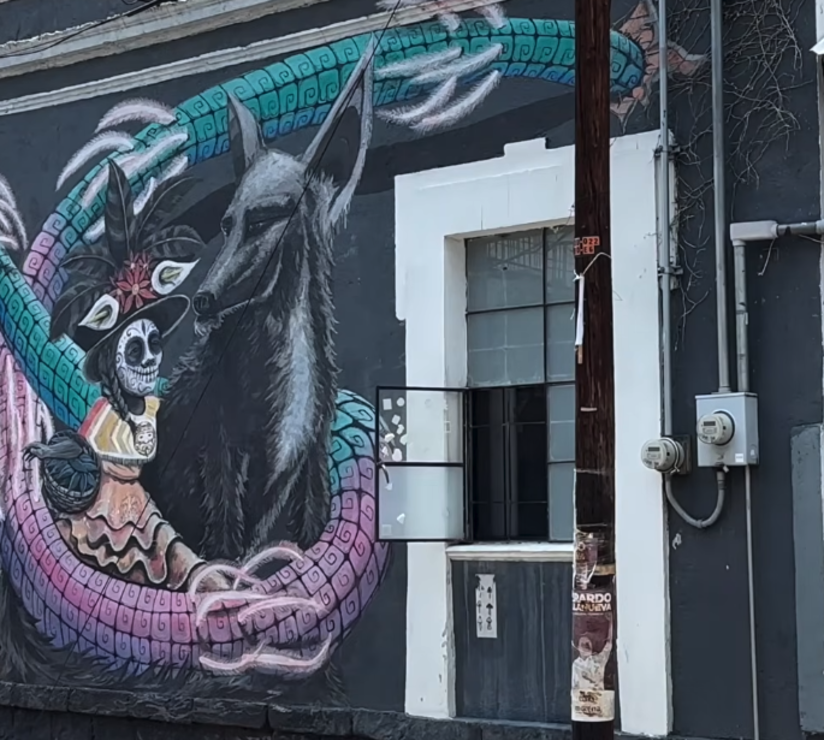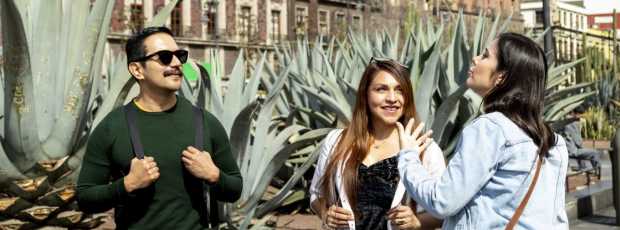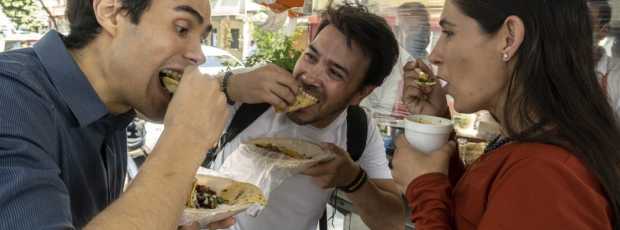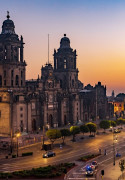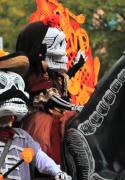Explore Mexico City Like a Local on a Private Tour
Real neighborhoods, local hangouts, your pace
Table Of Contents
- You Haven’t Really Done Mexico City Without These Neighborhoods
- Iconic Neighborhoods With Local Angles
- Creative And Emerging Districts
- Foodie And Market Neighborhoods
- Nightlife And Youth Culture Zones
- How Do These Neighborhoods Reveal Mexico City Through Food?
- Frequently Asked Questions About Mexico City Neighborhoods
- My Favorite Dusk Walks Through Mexico City's Hidden Heart
I walk this city to understand it. The neighborhoods that stay with me are not only the famous ones, but the quiet blocks where mornings start with coffee and small plazas open the day. This is the map I use on foot. You will find Mexico City Experiences that connect you with local hosts in these hidden neighborhoods.
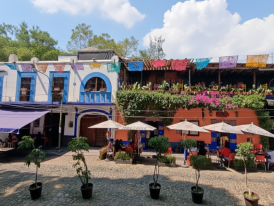
Coyoacán neighbourhood
The morning light lifts dust above cobblestones. Somewhere, a vendor calls “tamales.” I walk everywhere. I build my days around small plazas and markets.
This is how I met Mexico City. On foot and in its rhythm. It is a massive city, and walking makes it smaller.
The tamalero near the Biblioteca de México has kept the same corner for twenty years. Steam from his pot tells me more about a neighborhood than any checklist.
Most visitors chase the big routes. If you want the wide map, read things to do in Mexico City, then walk it block by block. People chase the hippest neighborhoods and miss the quiet blocks that hold the day together.
I turn into side streets where neighbors greet each other by name.
These Mexico City neighborhoods are the best for walkers. They reveal daily life through small plazas, markets, and slow tree-lined blocks that the city center cannot match.
If you want Mexico City experiences, start early, ride the metro, and walk the rest.
Experiences Created by Locals, Just for You
See the city through the eyes of the people who call it home.
You Haven’t Really Done Mexico City Without These Neighborhoods
These are the best neighborhoods in Mexico City to ground your first days on foot.
Centro Histórico
The Zócalo wakes early and feels cool and wide. I slip into side streets. I return at blue hour when Palacio de Bellas Artes glows. Two blocks from the square, the city bustle fades and the voices return.
Roma Norte
Coffee first, then Plaza Rio de Janeiro and Casa Lamm Cultural Center. It feels lived in. Less show. More daily rhythm. Trendy restaurants cluster near the gallerie,s and the talk keeps pace. Use this as a neighborhood guide and plan one slow loop at a time.
La Condesa
A long breath around Parque México. Dogs at play. Terraces warm up in the afternoon. Nights stay soft and easy to walk.
Coyoacán
Plaza Hidalgo and the market set a Sunday pace. Families first. Photos later. This calm keeps me coming back.
Iconic Neighborhoods With Local Angles
Start with the best neighborhoods in Mexico City and read them at walking speed. Landmarks help, but the side streets do the work.
Centro Histórico
I start early when the Zócalo is still waking up. The Metropolitan Cathedral feels larger when the square is quiet. I drift toward Templo Mayor for stone and story, then pause near Palacio de Bellas Artes at blue hour when lights find the marble. The icons draw you in. The side streets keep you there.
Roma Norte
My mornings begin with coffee and a slow loop past Plaza Rio de Janeiro. People read. Dogs pull their owners. Casa Lamm Cultural Center sets the tone for small talks about art and books. I choose one gallery, then one bar with low music. I let the pace decide the rest. Roma talks. Condesa strolls. Trendy restaurants sit near the galleries and the mood stays local.
La Condesa
Condesa feels like a long breath. I circle Parque México and watch the dogs work out their politics. Terraces fill in the afternoon. At night the volume stays friendly. I walk everywhere and never rush the corners. Come for the greenery. Stay for the easy evenings.
Coyoacán
Coyoacán holds its shape. Plaza Hidalgo sets a calm rhythm, then the market adds color and steam. Sundays bring families and time. I sit with a coffee and let the square pass by. Save a half day. Let the plaza lead you.
Polanco
Polanco is polished. Designer boutiques line the blocks, and luxury hotels keep things tidy. It works as a base if you want to order and get quick rides to the museum belt. Prices match the polish. Polanco gets called the Beverly Hills of the city, and some streets feel like it. There are great restaurants here, and you can walk between them with ease. I visit with a plan and eat outside the main strip. Smooth logistics. Higher spend.
Choose Juárez when you want nights that feel local.
Juárez
Juárez hides good rooms on quiet back streets. Small design bars. Wine lists that reward a second glass. Zona Rosa sits within Juárez, but the mood shifts by block. Softer lighting. Better conversations. Choose Juárez when you want nights that feel local.

Vintage, Art Deco theatre facade
Creative And Emerging Districts
On these blocks, the city thinks out loud. Small stages. Thirty chairs. A gallery door left open to the street. These Mexico City neighborhoods feel new without losing the neighbors. I go when I want to hear work before it becomes a poster.
Small Rooms, Big Imagination In San Rafael
I once followed applause through an unmarked door and found thirty people listening to poems about city nights. San Rafael mixes late-Porfirian and Art Nouveau townhouses with an Art Deco landmark, the long-closed Cine Ópera, which still holds the neighborhood's stage legend. Small venues keep the tradition alive with experimental theater and quiet shows for a few dozen people.
Converted apartments host galleries. Bookstores open again after hours. Cafés stretch the talk past closing. A few spaces feel like smaller cousins of Casa Lamm Cultural Center in Roma Norte. Exhibits mix local names and familiar ones. The surprises stay unpretentious. The block feels like a bohemian neighbourhood that still belongs to its neighbors.
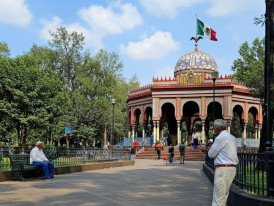
Kiosco Morisco in the park
Santa María la Ribera, The Historic Calm Around the Kiosco Morisco
I remember stepping under the Kiosco Morisco at dawn. Iron cooling. An old man sweeping the base in careful circles. Mornings smell like cilantro and fresh pages in used book shops.
The area carries Porfirian elegance and art deco notes beside modest homes. It is one of the best neighborhoods for architectural walks. Bookshops stock classic Mexican literature and new poetry. Owners talk you through a find over coffee. The plaza anchors the day. The side streets hold the charm with family places, firm pastry, and balconies that tell their stories. I come for family-run small businesses that remember your order and ask about your week. Its central location makes it easy to reach in a short morning.

Mercado Medellin Roma Norte
Market Rhythms and Working‑Day Kitchens In Escandón
I measure Escandón by its tortillas. The stall by Mercado Escandón hands me one hot from the press while I wait for carnitas. As long as it arrives warm and a little charred, the neighborhood is still itself.
The market hums with families and vendors who remember you. It is authenticity without performance and local life without a tourist layer. Tree-lined streets lead to family restaurants where three generations share one kitchen. New cafés sit beside old fondas, and the talk runs between taste and habit. You also find good restaurants that never needed a sign.
The best finds do not advertise. There is just a chalkboard and a steady lunch crowd. It has a down-to-earth vibe that feels like an extended family on the block. Escandón sounds like bicycle bells. Dozens ring through the afternoon as delivery riders thread the blocks. Planning evening activities? Consider Mexico City at night for nighttime experiences.
Imagine Having a Friend in Every City
Our locals share their city with you the way they live it: flexible, real, and unscripted.
See how it worksFoodie And Market Neighborhoods
I plan days by stalls and sidewalks. These are the best neighborhoods for flavor at street level. Go hungry and follow the crowds.

Narvarte al pastor restaurant stand
Narvarte's Al Pastor and Mid‑Century Corners
Evening calls neighbors to taco stands built over years of feedback. Street food here is part of Mexican culture, and it shows in every line and every grill. I still visit the same pastor stand from my twenties. The owner’s son runs the grill and remembers extra pineapple and no cilantro.
Midcentury buildings fit a simple rule here. Let taste lead. Family kitchens serve traditional Mexican cuisine and modern Mexican cuisine without a show. The mood differs from the cocktail bars in Roma Norte and La Condesa and not the gourmet hall buzz of Mercado Roma. The best bites sit on quiet corners where taquerías look plain and taste unforgettable. Mercado Roma is the gourmet food hall people mention but I eat on the street first. Everything you need for the best food experiences in Mexico City.
Hungry to Try Mexico's Food Yourself?
Taste and explore the flavors locals actually love.

Portales market aisles stacked with chiles and fruit
Portales, Mercado First Then Everything Else
Mercado Portales is the neighborhood’s economic heartbeat. Vendors arrive before dawn to stack fresh produce and prepare food. By mid‑morning, the aisles hum with regulars who shop by habit. I still buy chiles from Señora Carmen, partly for the peppers and mostly for the ten‑minute conversation that comes with each purchase.
Mexico City’s everyday market economy reveals itself in these long relationships between vendors and customers working the same stalls for years. Street food preparation happens in full view, building trust through transparency. You see a slice of Latin America in one aisle and you hear it too.
Roma Sur
Roma Sur is where lunch hours still matter. Market corridors, coffee windows, low-key counters that feed regulars. It’s less staged than its northern twin and a solid afternoon food walk.
Want to Experience All These Food Adventures Firsthand?
Step into the neighborhood, scene, or story with someone who knows it inside out.
Calm, Historic and Family-Friendly Corners
Here, the city lowers its voice. Plazas hold the afternoon, and stone slows the feet. I come when I want time to stretch.
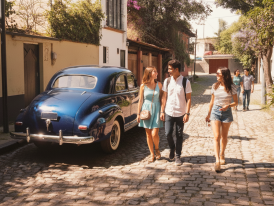
Chimalistac cobbled lane with shaded colonial walls
Chimalistac: Cobblestones That Slow You Down
In Chimalistac, my footsteps go softer, as if the stones insist on a slower pace; I come here when Mexico City hurries me too much.
Cobblestone streets wind between houses built yesterday or three centuries ago, an architectural continuity that makes time feel different. This neighborhood preserves colonial architecture and village‑life scale while sitting fully inside Mexico City. Sunday afternoons show the neighborhood at its most itself. Families in small plazas, artisans in converted courtyards, unhurried conversations that have mostly disappeared from tourist routes. Curious how this vibe plays out elsewhere? Start with a Mexico City neighborhoods guide.
San Ángel
Weekend art fairs, shaded courtyards, and cobbles that force a slower stride. I time San Ángel for late morning into lunch, when the lanes are lively but not loud. Bring flats. The stones call the pace. If Coyoacán is full, I cross here and let the courtyards cool the afternoon.

Mixcoac plaza benches beneath jacaranda blossoms in bloom
How Does Mixcoac Preserve Its Historical Identity?
Morning atmosphere revolves around historic plazas where neighbors meet for coffee before work.
Evenings bring a different energy as cultural‑center programming draws wider audiences.
I sometimes sit on a bench here with a concha and coffee, watching schoolchildren run across the plaza while their grandparents trade stories under jacarandas.
Programming often features well‑known artists, and rotating shows sometimes highlight Diego Rivera and his peers, names you’ll meet in exhibitions about art since Mexican independence.
Colonial traces remain visible in the street layout and details, still part of daily life rather than set‑piece attractions like the areas around Templo Mayor or the grand public buildings near Palacio de Bellas Artes.
A quiet lesson in how Mexico City grew from the Aztec capital to today.
You will hear stories about Hernán Cortés’s house in the south, though I come for the plazas and the talk.
Curious What You Won’t Find Online About Mexico's History?
Discover the side only locals talk about.

Doctores mural wall near Arena México on a busy night
Murals, Lucha, And DIY Culture In Doctores
Arena México’s neon promises lucha libre, but the neighborhood’s creativity spills from ring to street. Estación Indianilla shows the neighborhood’s knack for reuse, turning abandoned infrastructure into a community cultural space. Street art and murals tell stories about local history and present‑day concerns without translation.
One afternoon, I followed a muralist as he retouched a wall. He explained each color choice while neighbors stopped to comment. That conversation taught me that in Doctores, art belongs as much to the street as to the artist.
Galleries Beside The Park In San Miguel Chapultepec
I discovered San Miguel Chapultepec in Miguel Hidalgo by accident, following a classical guitar drifting from an open art gallery door one Sunday. The musician was rehearsing alone, unaware that his practice had drawn a small audience of neighbors on their walks. That’s how this neighborhood works. It rewards accidental discoveries.
Between old casonas and newer infill, modern architecture gives the galleries a crisp frame without stealing the work’s attention.
Galleries by noon, Chapultepec Park paths by afternoon. Lakeside loops make good resets between rooms. Museums nearby make rainy days easy.
Gallery openings feel like neighborhood gatherings rather than formal events, with artists and visitors continuing discussions at nearby pizzerias and cafés. This creates an environment where art remains connected to daily life in these neighborhoods in Mexico City.
A gentle, art-minded barrio next to Chapultepec Park. Ideal for slow, mixed-purpose strolls through Mexico City.
Feel Part of Mexico City
Locals share their city as they live it, so even a few hours can feel like you truly belong.
Tlalpan main square with church
Tlalpan, A Pueblo Heart Inside the City
Centro de Tlalpan keeps a plaza-centered social life. Historic buildings, colonial facades, weekend markets, families converging under the trees, much like San Ángel but farther south. Local businesses serve neighborhood needs first. My ritual is a tlacoyo in the shade of the old church. I never leave without a conversation.
Weekend markets here and in San Ángel. Focus on local crafts and regional foods around the main square. Tlalpan sits farther south, so plan Metro plus bus or Metrobús (or the Tren Ligero) rather than a short Metro hop. If you want a Saturday art fix, San Ángel is closer to central neighborhoods, instead of the floating gardens of Xochimilco. For more off-route discoveries, I highly recommend you look for hidden gems across the city.
Nightlife And Youth Culture Zones
I choose nights by volume and light. Small rooms when I want talk. Bright corners when I want noise.
Roma Norte, Juárez, and Zona Rosa run at different levels. Roma keeps conversation bars.
Juárez hides wine rooms on quiet back streets. Zona Rosa gets loud and late. Condesa stays soft with terraces and easy walking. Pick a lane and stay on foot.
Overrated Versus Real
Centro Histórico stays on my list. Go early or go late and use the side streets between the icons.
Zona Rosa is about timing, so I pass through in the early evening and choose design bars on Juárez back streets when I want a local mood.
This is where the vibrant nightlife lives when you want volume and light. If Polanco is peaking, I head to Narvarte for al pastor that matches the neighborhood’s pace and price.
If Coyoacán is packed, I shift to San Ángel’s courtyards off-peak for a calmer walk. I keep to safe neighborhoods by reading the crowd and staying where people are eating.

Morning tamales
How Do These Neighborhoods Reveal Mexico City Through Food?
Morning starts with tamales before sunrise. Markets show three generations at one stall. Night brings street food and talk that lasts.
My own loop follows that map. A tamal by the Kiosco Morisco. Lunch at a fonda in Escandón where the comida corrida holds steady. Narvarte at dusk for tacos al pastor made for people who eat them weekly.
You can chase polish near big sights, but the flavor lives in these streets. A little of Parque México finds its way into the day, yet the mood stays grounded and local.
Go Beyond the Mexico Nightlife Checklist
Discover the city guidebooks don’t cover with a local by your side.

Map showing the 10 neighbourhoods
Practical Tips for Exploring These Barrios
Think of this guide as walking invitations. Pick one or two areas and let the streets set the pace.
Getting around
Metro for most trips. EcoBici for longer links. I plan routes that avoid heavy traffic and keep transfers simple. I cut across on bikes to dodge car traffic when the lights stack up. Paseo de la Reforma and the museum corridors offer among the easiest step-free access and wide sidewalks.
Best time of day
Mornings for markets, afternoons for cafés and small galleries, early evening for street food when the air cools.
Accessibility and footing
Paseo de la Reforma and large public buildings like the National Museum are great for step-free access, though entrances and ongoing works vary. San Ángel and Coyoacán have cobblestone streets that slow you down, so plan shoes and time. Many historic areas feature uneven paving. Museums and modern neighborhoods generally offer better accessibility.
Safety
Use the same awareness you would in any big city. Stick to lively blocks at night. I feel better where people are eating than on empty streets. It is a populous city, and the mood can change by block, so keep your head up.
Costs
Polanco is the high spend. Roma and Condesa sit in the middle. Centro and San Rafael are often the best value.
I keep a short list of safe neighborhoods by day, and I shift plans by feel after dark.
Before You Go, Talk to Someone Who Knows
A local video call helps you plan the trip that’s right for you.
Frequently Asked Questions About Mexico City Neighborhoods
1) Which Hidden Neighborhoods Are Best for Food Experiences?
Narvarte for tacos al pastor, Portales for market meals, and Escandón for traditional fondas. They feel more local than the trendier spots around Parque Mexico or Roma Sur.
2) Is It Safe to Walk These Neighborhoods at Night?
Stick to well‑lit, populated streets and active food areas like Narvarte’s taco zones. I often feel safer among people eating than on empty avenues. Avoid the quietest centro historico corners late.
3) What Neighborhood Feels Most Like a Traditional Mexican Pueblo?
Tlalpan and Chimalistac both preserve village atmospheres, with Tlalpan maintaining more active plaza life and Chimalistac offering better-preserved colonial architecture. Both differ significantly from the urban energy of La Condesa or Roma Norte areas in Mexico City.
4) Where Can You Find the Best Small Art Galleries?
San Miguel Chapultepec and Roma Norte: converted apartments, rotating art exhibitions, and the odd art gallery hidden behind a plain door by a famous artist.
5) Which Areas Are Most Accessible by Public Transit?
Santa María la Ribera, Narvarte, and Doctores connect easily through metro stations, while others may require short bus rides or EcoBici connections throughout Mexico City.
6) Do These Neighborhoods Welcome Tourists?
These areas primarily serve local residents but welcome respectful visitors who engage authentically with vendors and community spaces in Mexico City.
7) What's the Best Time of Day for Neighborhood Exploration?
Mornings for markets, afternoons for cafés and galleries, early evenings for street food, especially around Roma Norte.
8) Are These Areas More Affordable Than Tourist Neighborhoods?
Generally, yes. Prices reflect the neighborhood economy, not Zona Rosa markups.
9) Which Neighborhood Has the Most Historic Architecture?
Chimalistac for colonial fabric, Santa María la Ribera for Porfirian and art deco buildings.
10) How Long Should You Spend in Each Neighborhood?
Plan 2 to 3 hours minimum for meaningful exploration, or full half-days if combining multiple activities like markets, galleries, and meal stops in Mexico City.
11) What Should You Bring for Neighborhood Walking?
Comfortable shoes, light jacket, small cash amount for vendors, and respectful curiosity about local life and customs in Mexico City.
12) Do People Speak English in These Areas?
English is less common than in tourist zones, but basic Spanish phrases and friendly gestures facilitate most interactions successfully throughout Mexico City.
13) Are These Neighborhoods Good for Solo Female Travelers?
Yes, with standard urban precautions, stay in populated areas, trust instincts, and engage with established vendors and business owners in Mexico City.
14) Which Area Has the Best Street Art?
Doctores for scale; smaller cultural pieces cluster around the older theater blocks.
15) Can You Find Good Coffee in These Neighborhoods?
Each area has developed café culture, with Santa María la Ribera and San Rafael offering particularly strong coffee scenes alongside traditional options throughout Mexico City.
I linger longest in San Rafael. There's a café where the barista knows my reading habits better than my friends do, always suggesting which corner table catches the best afternoon light for whatever book I'm carrying that day.

Alebrije Café in a quiet side street
My Favorite Dusk Walks Through Mexico City's Hidden Heart
Light changes everything in these neighborhoods. In Chimalistac, shadows lengthen across cobbles; in Santa María la Ribera, the Kiosco Morisco glows as the plaza fills with conversation.
I usually end at a corner café or cantina, watching families close up shop while street food stands open. Last month in Chimalistac, an older gentleman taught me a new domino game while an old bolero played on the radio. These moments don’t appear in guidebooks. They emerge when you give a neighborhood time.
These neighborhoods are where Mexico City shows its soul. If you’re willing to walk and watch. These are my favorite neighborhoods to walk at dusk.
If you want company, I can set the pace. I plan my walks through our Mexico experiences and choose the Mexico City routes that fit the day.
More on Mexico
Ready to Plan Your Perfect Day in Mexico City?
Start your experienceTravel Guides Can Only Take You So Far
We connect travelers with locals who shape days that actually fit your interests — not someone else’s checklist.
See how it worksWish you had a local friend in Mexico City
One who knows the city inside out and could plan a private day just for you? Our local hosts do exactly that: no scripts, no tourist traps, just the side of the city most people miss.
